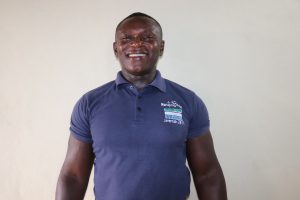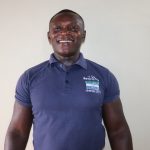December, 2022: Masheka Community Well Rehabilitation Complete!
We are excited to share that a safe, reliable water point at Masheka in Sierra Leone is now providing clean water to community members! We also conducted hygiene and sanitation training, which focused on healthy practices such as handwashing and using latrines.
"I want to express my sincere thanks to [you] for providing us safe drinking water at our doorstep," said 15-year-old Kadiatu S.
"It was difficult for us to practice proper handwashing since we [did] not have safe and pure water. We were facing challenges to have enough water to use for domestic purposes. With [your] help giving [us a] safe and pure drinking water point, this will help us practice proper handwashing and minimize the water sicknesses we [used to] get from [the] contaminated water we used to drink."

Kadiatu, right, in the yellow shirt, celebrates at the new well.
"I can fetch enough water for my mother to prepare food on time, and this water point will help [me] to fetch water early and go to school on time," Kadiatu continued. "We school-going children can now get quick access to fetch water, wash cooking utensils, bathe, and get to school on time. This water point will help me to have time to rest and help my parents with other home activities that [are] required to [be] done on time."

Sama splashes water with other community women - Kadiatu is in the second row.
"Today, I am happy for the new water point that [you] provided to us," said 48-year-old farmer Sama Bangura. "The community women and children are indeed happy for the safe drinking water point because we [have] always [been] worried [about] water to be used for cooking, drinking and for processing palm kernel oil."

Sama (in the black shirt) collects water from the rehabilitated well.
"This water point has rested my worries of [getting] bites from wild animals [when we used to] fetch water from the swamp," Sama continued. "I can fetch enough water, since the water point is close to my home, and deal with other activities. I will fetch water even [when] my children are not at home, and it will give my children [time] to read their lesson notes."

The District Councillor, Mapping Officer, and Village Headman cut the ribbon for the dedication ceremony.
We held a dedication ceremony to officially hand over the well to the community members. Several local dignitaries attended the ceremony, including representatives from the Port Loko District Council, the Ministry of Water Resources, and the Ward Council. Each official gave a short speech thanking everyone who contributed to the rehabilitation of the water project and reminding everyone to take good care of it. Then, Kadiatu and Sama made statements on their community's behalf. The ceremony concluded with celebration, singing, and dancing.

Clean Water Restored
The drill team arrived the day before beginning work. They set up camp and unpacked all their tools and supplies to prepare for drilling the next day. The community provided space for the team to store their belongings and meals for the duration of their stay. The following day, the work began.
First, we raised the tripod, the structure we use to hold and maneuver each drilling tool. Next, we measured the well's original depth. We then socketed the pipes and installed a casing.

Finally, we lined up the drill rods and started to drill! We reached a final depth of 15 meters with water at 12 meters. The hand-drill method allowed the team to install the cylinder far below the aquifer so that the community has excellent water access throughout the year.

With drilling complete, we installed screening and a filter pack to keep out debris when the water is pumped. We then cemented an iron rod to the well lining and fixed it with an iron collar at the top.
Next, we bailed the well by hand for three days and flushed it, clearing any debris generated by the drilling process. Finally, we tested the yield to ensure the well would provide clean water with minimal effort at the pump.

Bailing.
As the project neared completion, we built a new cement platform, walls, and drainage system around the well to seal it off from surface-level contaminants. The drainage system helps to redirect runoff and spilled water to help avoid standing water at the well, which can be uncomfortable and unhygienic and a breeding ground for disease-carrying mosquitoes.
At last, we installed the pump and conducted a water quality test. The test results showed that this was clean water fit for drinking!

New Knowledge
Before conducting any hygiene training, we called and visited the local water user committee to understand the community’s challenges and lack of sanitation facilities. We shared the findings from our discussions with the committee members to help them make the necessary adjustments before the training began. For example, we identified households without handwashing stations or ones that may need to repair their latrines. With this information, community members worked together to improve hygiene and sanitation at home.
After this preparatory period, we scheduled a time when members from each household using the water point could attend a three-day hygiene and sanitation training. We then dispatched our teams to the agreed-upon location to hold the meeting.
People came out in droves for the training, which really impressed our team. We requested attendance from one member of each household, and more than double that amount showed up! They asked lots of questions and contributed to the group discussion.

Training topics covered included handwashing and tippy taps, good and bad hygiene habits, disease transmission and prevention, COVID-19, worms and parasites, dental hygiene, proper care of the well's pump, keeping the water clean, the cost recovery system, dish racks and clotheslines, the importance of toilets, keeping latrines clean, balanced diets, the diarrhea doll, and HIV and AIDS.
One of the more lively discussions concerned proper handwashing techniques. We showed community members how to construct simple handwashing stations using inexpensive, locally available materials.

A community member constructs a tippy-tap handwashing station.
The village headman, Baba Bangura, explained that the community members couldn't afford to replace the Veronica bucket that was donated to their mosque during COVID-19 when it was destroyed, so finding that there was a more economical way to ensure the entire community could practice proper handwashing was a big relief to him.

At the end of the handwashing discussion, one of the community women reminded everyone to wash their hands not only after using the latrine, but also before cooking meals and touching their children, which everyone else in attendance applauded her for.

Another discussion that had people asking a lot of questions was the topic of diarrhea, which has been a big problem in this community. People were dismayed to learn that the traditional treatments they were using for children who experience diarrhea (like chewing raw rice, cassava, and local herbs) wouldn't help. However, we told them about Oral Rehydration Solution, which can easily be crafted at home now that the community has access to a safe, reliable water source.
"The training was so much important to me because it has helped me learn so many things that will help me improve my way of living," said Sama Bangura, whom we quoted earlier.

Sama on the day of the training.
"During this training, I have gained knowledge about the things that we thought were simple but were the most harmful to us, like walking barefoot, eating foods without washing them, or our hands. I have realized that handwashing, especially after using the latrine, is so much necessary. It is also clear to me that diarrhea only attacks us once we consume contaminated foods and water.
"Also, the knowledge of preparing the Oral Salt Solution (ORS) at our homes is very much valuable to know since diarrhea has respect for no one. Walking barefoot can lead to worm infestation, especially in younger children. I have learned how to take proper care of my environment, myself, and [my] family to stay healthy and strong, and I strongly believe other members of this community will do the same."
Conclusion
This project required a substantial collaboration between our staff, our in-country teams, and the community members themselves. When an issue arises concerning the well, community members are equipped with the necessary skills to rectify the problem and ensure the water point works appropriately. However, if the issue is beyond their capabilities, they can contact their local field officers to assist them.
Also, we will continue to offer them unmatchable support as a part of our monitoring and maintenance program. We walk with each community, problem-solving together when they face challenges with functionality, seasonality, or water quality. Together, all these components help us strive for enduring access to reliable, clean, and safe water for this community.
With your contribution, one more piece has been added to a large puzzle of water projects. In our target areas, we’re working toward complete coverage of reliable, maintained water sources within a 30-minute round trip for each community, household, school, and health center. With this in mind, search through our upcoming projects to see which community you can help next!
Thank you for making all of this possible!




 Borehole Well and Hand Pump
Borehole Well and Hand Pump




































